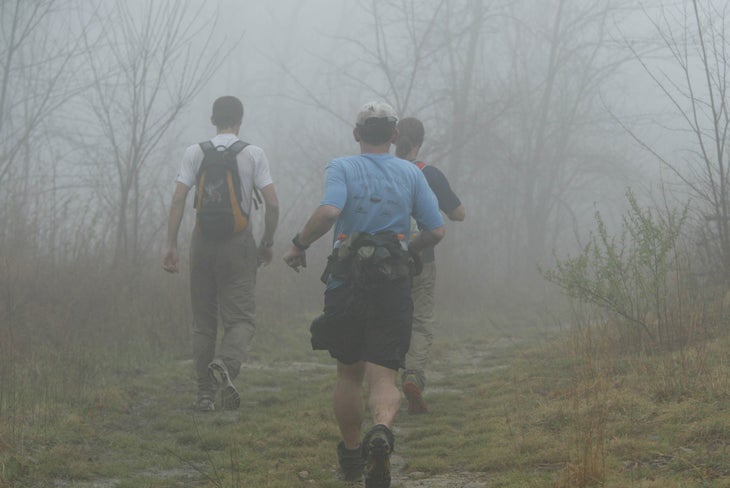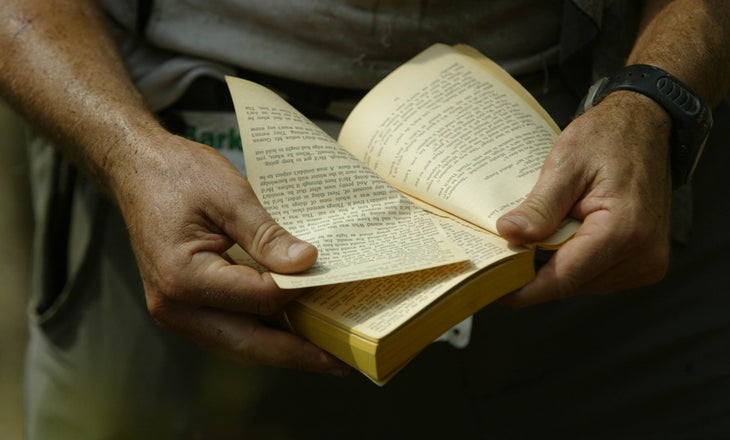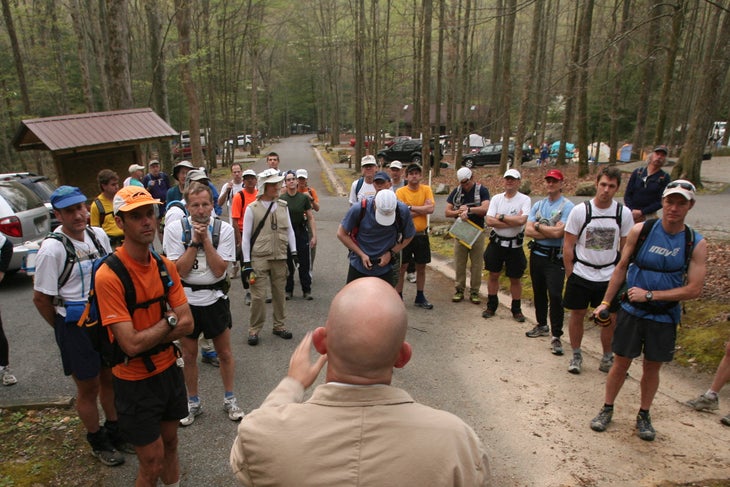New perk! Get after it with local recommendations just for you. Discover nearby events, routes out your door, and hidden gems when you sign up for the Local Running Drop.
At 5:17 A.M. eastern on Wednesday, a bearded, bespeckled man lit a cigarette and a gaggle of people ran past a yellow gate and into the dense woods of Frozen Head State Park in Tennessee.
That man is Gary “Lazarus Lake” Cantrell. The gaggle is a collection of some of the most meticulous, perseverant, and hardened ultrarunners in the world. The 2024 Barkley Marathons have begun.
There is perhaps no footrace surrounded with more lore, mystery, and intrigue—yet so little information. Barkley is notoriously nearly impossible to finish. For the first 36 years only 15 people had completed it, until last year when a record-tying three runners, Aurelian Sanchez, Karel Sabbe, and John Kelly, successfully tackled all five loops within the 60-hour cutoff.
That finishing rate is probably too high in the eyes of race founder Cantrell, who goes by “Laz” in these circles. So buckle up. Here’s what you need to know about the iconic “100” mile race.
View this post on Instagram
Who’s Running (That We Know Of So Far)
The 40 or so entrants include a mix of veterans and Barkley virgins, headlined by Jared Campbell, 44, of Utah and the only three-time Barkley finisher in the race’s 38-year history. He’s joined by more Barkley royalty in John Kelly, 39, who is gunning for his third finish over seven attempts. An American who lived in the U.K. with his family for the last several years, Kelly recently moved stateside, in fact to Tennessee. He’s joined by fellow 2023 finisher Sanchez, 33, of Spain.
The U.K. ‘s Jasmin Paris, 40, is back to improve upon her impressive performance from last year, in which she became only the second woman ever (after Sue Johnston) to attempt a fourth loop. While she missed the 48-hour cutoff to continue onto loop five, she’s back this year armed with experience and extra resolve.
This will be Paris’s third attempt, along with Harvey Lewis, 47, of Ohio—who won Laz’s other iconic event, Big’s Backyard Ultra in 2023—Albert Herrero Casas, 41, of Spain, Greig Hamilton of New Zealand, and Aaron Bradner from Virginia.
RELATED: How Jasmin Paris Conquered the Barkley Marathons “Fun Run”
Other notables include Damian Hall, 50, of the U.K., who finished fifth at UTMB in 2018 and has set stiff Fastest Known Times on the Pennine Way and the Paddy Buckley Round, among others. He’s back for his second attempt. Japan’s Tomokazu Ihara, 46, is back for a fifth attempt, and Kelly Halpin, 38, holder of numerous unsupported, technically and physically FKTs including the Wind River High Route and the Wasatch Ultimate Ridge Linkup, is attempting her first Barkley.
How It’s Unfolding
One runner described the new section as “brambly” and “pitchy.” #BM100
— Keith (@keithdunn) March 20, 2024
Last year, Laz told Trail Runner that he “made it easier to assure a finisher.” If he’s being honest, it worked. After a record-breaking three finishers, it’s safe to imagine that the course will be harder than ever before. But the bluebird weather will play in the runners’ favor.
According to @keithdunn, the unofficial official source for Barkley race updates, 22 runners successfully completed loop one within the time cutoff and have moved onto loop two.
Just before 1 A.M. on Thursday morning, Kelly, Paris, Hall, Sebastien Raichon, and Ihor Verys finished loop two together.
We will continue to update the action as we learn more.
What is the Barkley Marathons
On paper, the Barkley Marathons is a race composed of five 20- to 26-mile loops with about 12,000 feet of climbing each, for a total of about 130 miles and 60,000 feet—that’s two Everests! But it’s so much more than that. For one, there is no marked route. The day before the race, participants are given a blank topographic map of Frozen Head State Park, which they can use to plot out the 10 to 15 books marked on Laz’s master map. Yes, books, you read that correctly. There are books along the route serving as waypoints, and runners must find each book on each lap (as well as tear out the page corresponding to their bib number. If they are so lucky to move onto another lap, they’re given a new bib).
No GPS devices or phones are allowed. Map and compass only.
While runners know what day the race will start well in advance, they do not know the start time until exactly one hour beforehand, when Laz blows a conch shell. That could be at midnight, it could be at noon. One hour later there is a brief memorial and Laz lights a cigarette to mark the start.
Runners have 12 hours to complete each lap. While the race always contains a mixture of clockwise and counterclockwise loops, their order changes year-to-year. When (and if) a runner is fortunate enough to make it to that elusive fifth loop, they get to choose the direction. The next runner, if there is one, must go in the opposite direction, and so on.

Why it’s So Hard
So Barkley is an orienteering race? Well no, according to a source who has participated in the race previously and requested to remain anonymous.
“In orienteering, you are generally in open spaces and you can see everything around you so you just shoot for the bearing and follow it,” our source explains. “That doesn’t work in Frozen Head State Park. It’s super dense, and everything looks the same.”
The largely off-trail route, which changes every year, takes runners through dense, scrubby forest and thick, prickly brambles. It goes up punchy climbs—30 to 40 percent—and if you’re not careful you will get cliffed out.
“There are grades where I was literally crawling on my hands and knees,” our source says. “Everything looks the same, there is no high point with views to survey where you are.”
In a short respite from the punchy climbs and clingy underbrush, runners must famously pass through an aqueduct that travels under the Brushy Mountain State Penitentiary. Some years it’s so flooded that runners are wading through waste-deep water.
In addition to the mind-bogglingly and mind-melding steep, dense terrain, runners must contend with highly variable and oftentimes highly inclement weather. Sometimes it’s below freezing and raining, snowing, sleeting, icy, and foggy. Others it’s a scorching 80 degrees Fahrenheit without a cloud in the sky. This year the runners seem to be lucking out with bluebird skies and temps ranging from 35 overnight to high 60s during the day.
RELATED: Multi-Day Runners are Alarmingly Sane
Then there’s the sleep deprivation. Runners expedient enough to finish well below the 12 hour cutoff for each lap can choose to recuperate, while others squeaking in at the last second won’t have that luxury. And inevitably as the race unfolds and the sun sets, wayfinding grows exponentially harder. One wrong turn can tack on miles—and hours.
It’s exactly this random arbitrariness that makes Barkley so mentally taxing—and so appealing to so many. Every finisher has worked in the math or science sphere, according to our anonymous source, and we can imagine that the allure of surrendering control for 60 overs in the year holds some mystical appeal if it doesn’t drive you away for good.
The Rules
Runners hoping to take part in Barkley must figure out how to apply on their own, along with a $1.60 entry fee. The lucky, or should we say unlucky, few selected receive a letter of condolences. Virgin Barkley runners must bring a vehicle license plate to the start, while vets must bring an item of Laz’s choosing. Sometimes that’s a T-shirt, others a pair of socks.
Runners are allowed one crew member each, who may venture to the top of the lookout tower about four miles into the course, but must stay off the course and are not allowed to provide aid or talk to races while up there. There are two water stations along the course, otherwise runners must carry their own supplies, restocking after each loop.
Traditionally, runners and crew camp out in tents before and during the race. As camping technology has improved over the race’s 37-year running, Laz has banned RVs. Sprinter vans are OK.
Barkley is not open to the public, and the secretive nature of the start is to deter eager fans from showing up and tipping capacity over Frozen Head’s official regulations.
Runners who complete three laps are awarded a “Fun Run.” And every runner who fails to complete the race is officially pulled from the course to the tune of Taps, played on a bugle trumpet like at a military funeral.

It’s a Joke—Sort Of
The Barkley Marathons were conceived by Laz and Karl Henn, also known as “Raw Dog,” after James Earl Ray, the assassin of Martin Luther King, Jr., famously escaped from Brushy Mountain State Penitentiary in 1977. Over nearly 55 hours, Ray made it about 12 miles through the woods before getting captured.
“People think it’s a tribute to James Earl Ray. It’s not a fucking tribute to James Earl Ray,” our source says. “It’s supposed to make fun of the fact that he couldn’t get very far.”
“I could do at least 100 miles,” Laz said. Barkley, named after Laz’s neighbor and running buddy Barry Barkley, was born to mock Ray and what Laz considered his feeble escape.
The event quickly morphed from proving a point to pushing the limits of human potential. Laz famously designs the course to be hard enough that most—if not all—will finish. How else will they discover what they’re capable of?
How You Can Follow the Race

While we may be firmly in the era of the race livestream, you’re going to have to settle for some good, old fashioned coverage on Twitter, now X. @keithdunn is the unofficial official source, as well as @dav1dmiller and @jeremy.gerber. Amelia Boone (@arboone11) has announced she has been given permission to reshare Dunn’s tweets on Threads.
You can also find some photos on Instagram and other social media sites, but with limited-to-no cell service in Frozen Head, don’t get your hopes too high. Instead while you wait for runners to complete another loop, you can indulge in the 2014 documentary, Barkley Marathons: The Race That Eats Its Young. There’s also a photo essay called The Finishers, which highlights through the stories of the first 15 individuals to complete all five loops. And Frozen Ed Furtway, who attempted the race more than a dozen times and became the first finisher in 1988, back when the race was about 50-55 miles with 25,000-ish feet of climbing, self-published Tales from Out There, a historical account of the race.